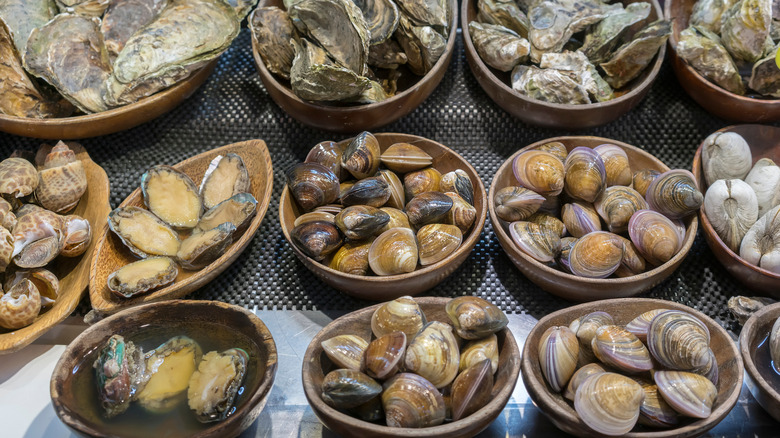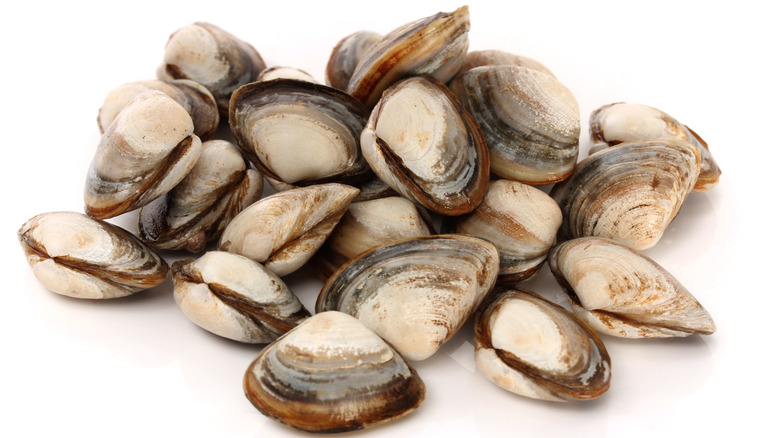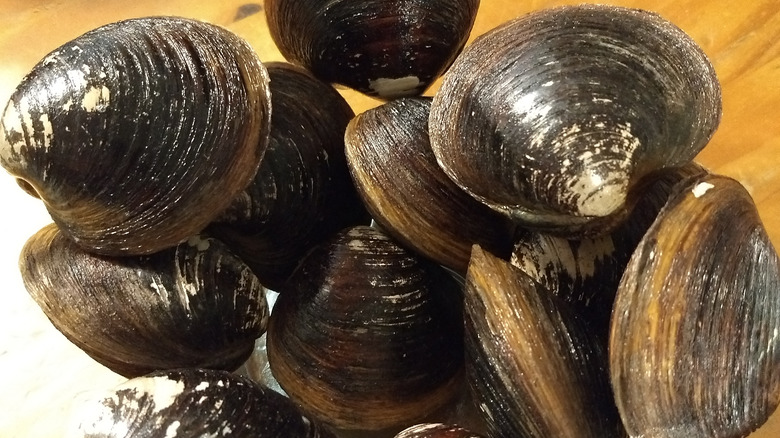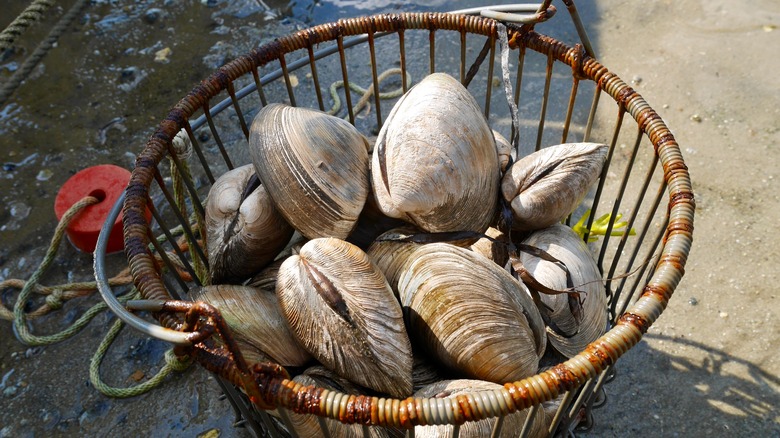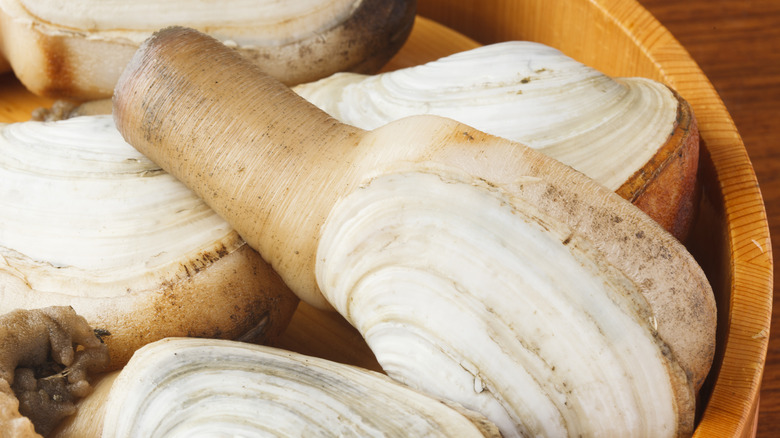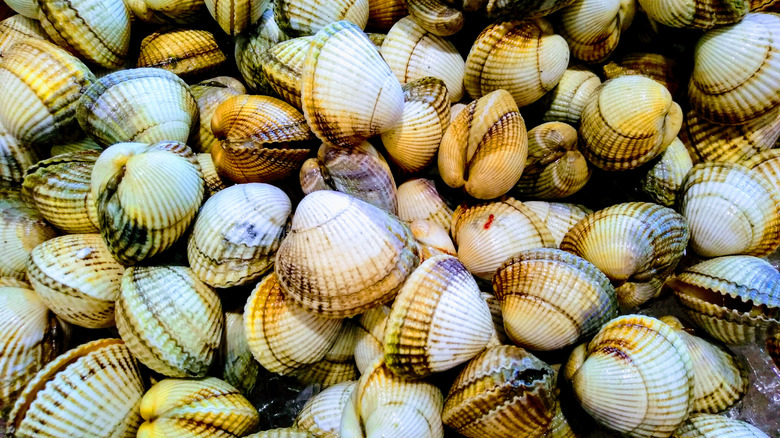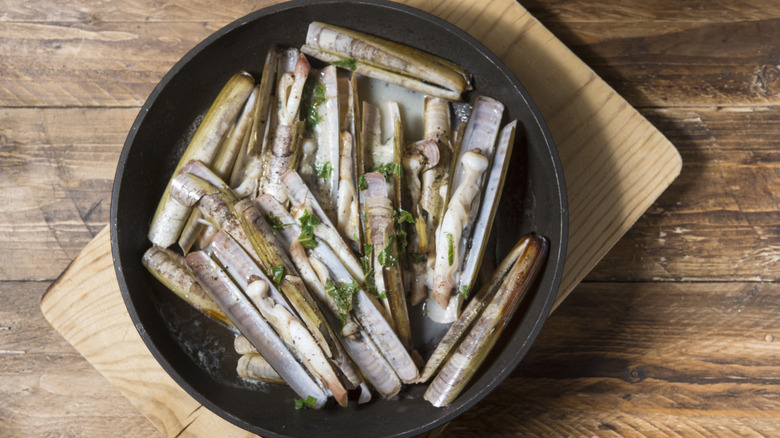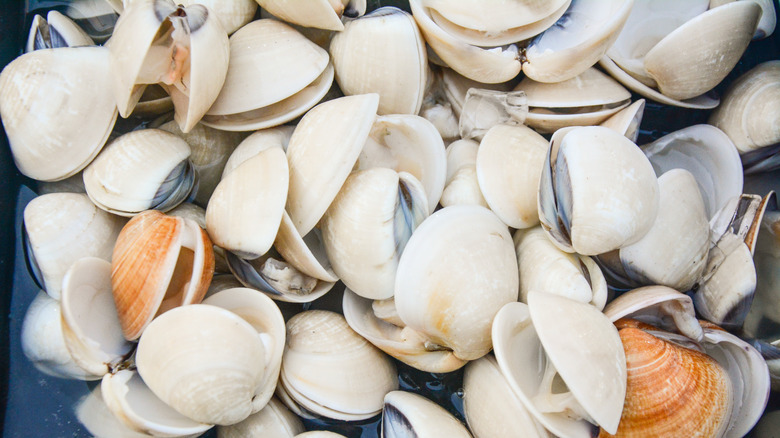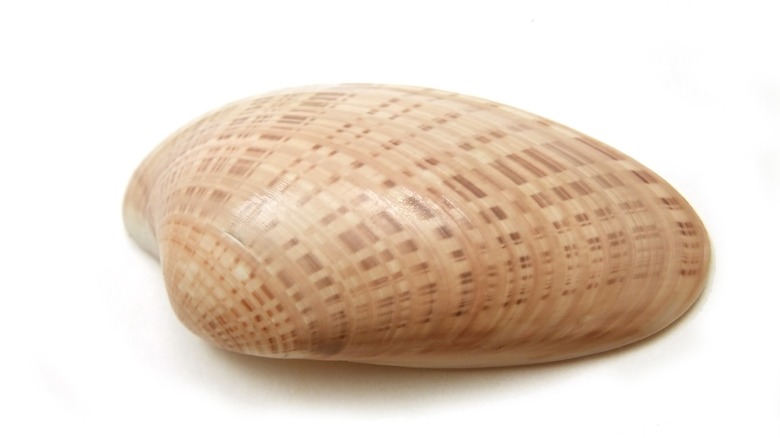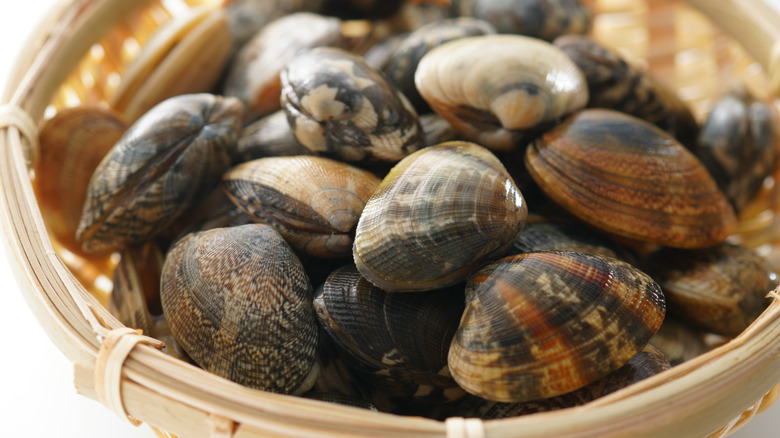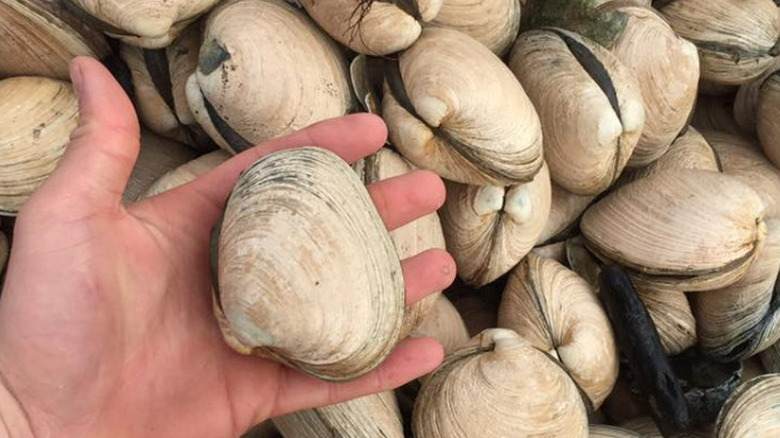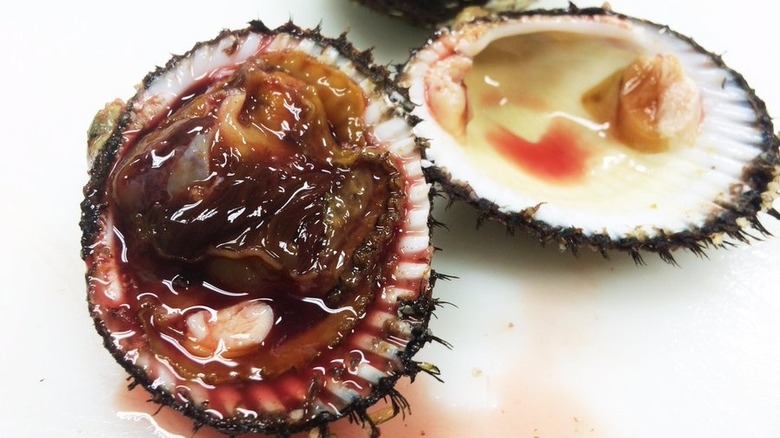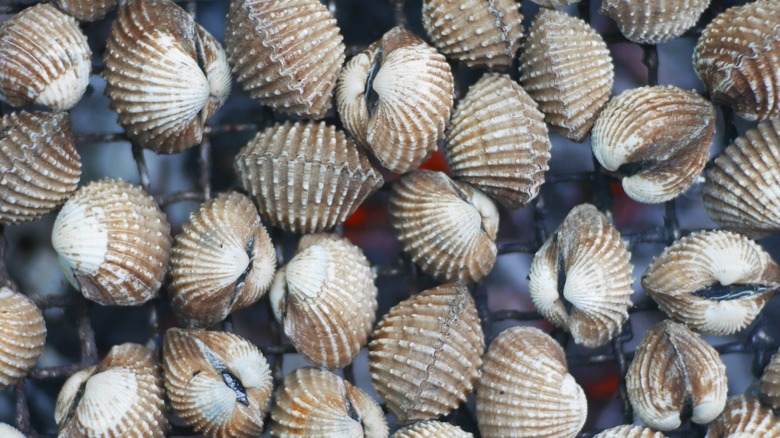The Ultimate Guide To Clam Varieties
For thousands of years, clams and humans have enjoyed a friendly relationship, with humans having played a role in the thriving success of these briny mollusks. Today, warming oceans and changing seafloor affect the well-being of clam species, but conservation efforts are underway to protect these salty treasures, from massive aquaculture farms to traditional clam gardens managed by indigenous people in the Pacific. And there are many reasons to do so: Clams are an exceptional treat for anyone looking to taste the natural flavors of the ocean.
Clams come in various sizes and shapes and are a popular food worldwide, being a diverse ingredient in a variety of dishes. They make excellent chowders and soups like the creamy crab and clam soup and can be steamed in sake with soy and pine nuts for a delicious appetizer. The best part is that they are sustainable seafood and easy to prepare. Before you start cooking with clams, you need to know your shells first. While there are thousands of varieties of clams, read on to learn about some of the most popular you are likely to come across on your seafood adventures, from quahogs on the East Coast to mesmerizing Pacific geoducks on the West.
Atlantic surf clam
Atlantic surf clams are delicious but often overlooked bivalves found in the western North Atlantic, mainly in Georges Bank, the southern Long Island, and the Delmarva Peninsula. This impressive clam can grow up to 9 inches and boasts yellowish-white shells. But beyond its remarkable size and appearance, the Atlantic surf clam is also a sustainable seafood choice particularly loved by Japanese chefs.
For high-end sushi, the Atlantic surf clam is often served steamed as nigiri or sliced for raw preparations. The largest Arctic surf clam harvested in the Atlantic, Hokkigai, is a popular choice for sashimi. Its sweet, delicate flavor pairs perfectly with sushi rice and soy sauce. But sushi and fine dining cuisine aren't the only ways to enjoy the Atlantic surf clam.
Despite the hearty labor of shelling and belly removal when prepping the surf clam, most cooks agree that the resulting taste and texture make it a valuable ingredient. From classic clam pasta and creamy chowder to enticing cold appetizers, this clam can be used in many creative applications.
Mahogany clam
Produced primarily in the Northeast U.S. and Eastern Canada, mahogany clams are a true delicacy that every clam lover should try. These clams have a distinctive taste and higher salinity, making them an excellent choice for any seafood dish. Mahogany clams are inexpensive, and chefs love using them as a worthy alternative to the popular quahogs. You can also mix the two for a budget-friendly meal option.
One of the standout features of the mahogany clam is its distinct dark brown color and circular, flattened shell, ranging from 1-½ to 2-½ inches. Their shells are less likely to peel, adding to their visual appeal.
Prepping mahogany clams is easy. First, rinse them with cold water to remove sand or grit, then boil them in a flavorful broth for up to 10 minutes until fully open. Alternatively, for an easy way to impress your guests, grill them on medium-high heat until they pop open and serve them with a glass of wine and some nice crusty bread.
Ocean quahog
Ocean quahogs are bivalve mollusks with dense, oval-shaped shells found in the waters of the western Atlantic as far south as Cape Hatteras, North Carolina. With a lifespan of at least 200 years, they are some of the longest-lived marine organisms, and their age can be determined by counting their growth rings. Quahogs have multiple names depending on their size: Little necks are the smallest, cherrystones are larger than top necks, and quahogs are the biggest of the type.
Quahogs are a quintessential part of Rhode Island cuisine, featured in various soups and stews. Visit George's of Galilee for its famous quahog chowder and try the baked "stuffies" too — a traditional dish you don't want to miss. The latter involves stuffing quahog shells with ground quahog meat, bread crumbs, onion, green pepper, celery, garlic, parsley, and thyme. While recipes may vary, it's a mouth-watering treat.
To prepare quahogs for a casual meal, merely soak them in cold water to clean them, then steam them until the shells open. Once ready, simply dip the tender, succulent meat into the buttery sauce and enjoy the freshness of the ocean. Or, of course, you could make an Italian feast with clam linguine.
Pacific geoduck
If we travel to the northern coast of the Pacific, we'll find one of the world's most misunderstood marine creatures, the geoduck clam. Boasting a weight of up to 8 pounds and a remarkable lifespan of 200 years, it's one of the largest burrowing clams and the most extended living creatures on the planet. Its long, wrinkled neck protruding from a massive shell may not be particularly attractive, but its sweetness and crunchy texture makes it a sought-after delicacy.
Geoduck clams are an excellent choice for raw seafood dishes, such as sashimi or ceviche, due to their light, tangy flavor with just the right amount of brininess. This delicacy is celebrated across Asia, particularly in Japan, where it is commonly used in sushi. In Korea, geoduck clams are frequently served raw with chili sauce and cooked in stir-fries or soups.
Geoducks are a must-try delicacy if you're willing to overlook their amusing appearance. One fully grown geoduck is enough to feed four people despite its hefty price, reaching $45 per pound. Cleaning them is relatively simple; give them a quick blanch to remove the outer membrane. When it comes to cooking, the trunk of the geoduck is best served raw, while the body is most tender when sautéed with garlic or ginger.
Pismo clam
Once abundant along the California coast, the Pismo clam is a small clam with a hard, triangular shell. They were particularly famous in Pismo Beach, once dubbed the "Clam Capital of the World." Tourists used to rent clam forks to dig them up until their population drastically declined in the 80s.
In 2021, to the delight of the locals, the Pismo clam made a surprise return leaving everyone puzzled. Researchers suggest that overcrowding caused the clams to come to the surface, a possible sign that their population is growing. Despite the Pismo clam's resurgence, the law only permits 10 clams per day, at least 4 to 5 inches in size, depending on where they are collected.
Those lucky enough to sample the legendary clams will discover the subtle-tasting meat beneath the small hard shell, which is perfect for steaming, pan frying, or grilling. Its texture is chewy and tender and pairs well with fragrant herbs and spices. The flavor is a combination of slight saltiness and sweetness.
Razor clam
The razor clam is a highly sought-after mollusk found on North America's west coast, primarily Alaska. The most common species is the Pacific razor clam, valued for its precious, soft flesh and characteristic long, thin shell. It may grow to 7 inches long and change color as it ages, making it a truly authentic sea delicacy. Unlike most clams, the razor clam looks more like a squid, which adds to its attractiveness.
If you're tempted to try razor clams for the first time, start with fresh clams that meet the Marine Conservation Society's guidelines. This means avoiding clams below 10 centimeters long and steering clear of foraged clams from May to September. Fresh razor clams should never be submerged in fresh water, which will cause them to drown. Instead, keep them in a fridge wrapped in a damp cloth, if needed overnight.
To prepare razor clams for cooking, ensure they are closed and remove any sand by rinsing them in cold water. Steaming or baking are the most classic approaches to cooking razor clams. After cooking, remember to remove the 'foot' and the central dark intestinal tract (as you would with shrimp). Overcooking razor clams can make them hard, so gentleness is required. They pair well with classic French garlicky butter and wine or rich Asian dark soy and fresh ginger flavors.
Softshell clam
Soft-shell clams are a popular type of clam found hiding in the sand and mud along the east coast of North America. These clams have a soft shell and an oval shape and can grow up to 4 inches long. While they were once commonly harvested in the Chesapeake Bay, the number of clams harvested in Maryland has declined due to disease and catch limits.
Steamers (steamed soft-shell clams) are New England's beloved summer seafood tradition, and it all starts with the digging. If you can see a small hole in the sand on the low tide, chances are you're lucky. Once you find your catch, you must pull it from the shell and remove the black mantle from its neck. There are plenty of ways to cook soft-shell clams; clam chowder is one obvious choice. The traditional New England version calls for cooking clams in salted water and serving them with flavored butter. The butter sauce is usually spiced with a squeeze of fresh lemon juice, herbs, garlic, white wine, or light beer. For a crispy seafood treat, try soaking the steamed clams in milk and frying them in corn flour batter.
Sunray Venus clam
Sunray Venus clam is a visually stunning and delicious clam found along the southeastern coast of the United States. Among the many clam species, the Sunray Venus stands out with its oblong shape, sizeable meat volume, and an almost complete half-shell. Its gleaming and sleek surface showcases a sun-ray-like pattern, earning its name. Although commercial harvesting of Sunray Venus clams was limited due to poor distribution, their market potential has made them popular for aquaculture in Florida.
Fresh Sunray Venus clams should always have a subtle aroma of the ocean. Be sure to also check for any cracked shells when buying clams. Once you've picked up some Venus clams, keep them in the fridge with the lid open to allow excess liquid to drain out. Venus clams tend to open when refrigerated, so warming them before cooking is best.
Sunray Venus clams are ideal for quick grilling, baking, or roasting. Cook them until the shells turn a delicate peach-to-coral hue and the meat inside becomes beautifully tender. Savor them in their shells, drizzled with a warm, buttery sauce or a tangy fresh salsa. Alternatively, you could spoil yourself with clams cooked in a curried coconut sauce for a tropical take on the classic.
Manila clam
Brought to British Columbia from Japan in the 1930s, the Manila clam has since thrived throughout the central coast of British Columbia to California. These oval-shaped clams grow up to 30 inches and can live up to 14 years. The colorful patterns of the Manila clam's shells are widely recognized, varying from off-white to yellow, brown, or grey, adorned with black, red, or blue stripes. They have been extremely popular, with the high demand pushing for Manila farms to replace the wild varieties.
With their gentle sweetness and soft texture, Manila clams are favorite among seafood enthusiasts; their extended shelf life makes them sought-after seafood among chefs. The clams are a pleasure to cook with as they pop open effortlessly when steamed. They can be prepared in various ways, from grilling and baking to more traditional steaming. They pair well with classic garlic butter, white wine, and fresh herbs to create exceptional entrées, and can be minced to include in creamy chowders.
Butter clam
If you like digging for harder-to-find shells, the butter clam is one to put on your list. This tasty mollusk lives on the Pacific coast from Alaska to California. These shelled critters are oval, with big, thick bodies that can grow 5 inches long. They're also tough creatures, with a lifespan of more than 20 years. Butter clams are recognized for their light texture and sweet flavor. They are frequently found in saline waterways like Coos or Tillamook Bays (if you happen to be nearby).
Butter clams are hugely versatile, too, with their mild buttery flavor enhancing rich chowders to landing in seafood pasta or soul-warming soups. Cooking them is simple: Just as with most clams, boil them until the shells gracefully open to reveal delicate morsels of luxurious meat. Eating butter clam raw is a rare treat, and you'll have to carefully shuck the flesh from both shells and rinse the remaining sand. But first, ensure the clam is alive by gently tapping the neck to elicit a response. This way, you'll know you have the freshest clam possible.
Blood clam
Blood clams are an exquisite treat known for their vivid red blood. While Chinese blood clams have been banned in the U.S. for their association with dangerous blood diseases, those found in the muddiest reaches of the bays along the eastern coast of the Americas are deemed safe.
Despite their notorious reputation, blood clams are considered a fine delicacy. For culinary enthusiasts, prying open these gems is undoubtedly worth the effort. We recommend using an oyster knife or blanching them in boiling water to make the process more manageable. The clams have a satisfying crunchiness akin to geoduck and possess a less salty flavor profile than most other clams.
In South America, blood clams are often found in ceviche. Another fragrant seafood dish to try is the Cambodian ngeav chhar ampil tumis: stir-fried blood clams with tamarind and basil that strikes beautiful contrasting colors on the plate. Meanwhile, grilled blood clams in Vietnam with onion oil, ram, fried garlic, and roasted peanuts have been a local favorite for years. A word of caution: Only buy blood clams from a reputable supplier if you dare to indulge in this unique delicacy.
Cockles
Cockles, once considered nothing more than bait, have become a highly sought-after delicacy at upscale restaurants thanks to their sustainability and richness. While there are over 200 species of cockles globally, only a select few are commonly used for consumption. These "hard-shelled" clams reside in coastal intertidal zones and lagoons, feeding on organic debris, phytoplankton, and algae, and therefore must be thoroughly cooked before consumption. The cockle industry is not as strictly regulated as the clam industry. However, you shouldn't be worried; most cockles sold in the U.S. come from reputable sources in Australia and New Zealand.
With their unique heart-shaped shells and pronounced sweetness, cockles are a must-try for anyone passionate about quality seafood. The easiest way to prepare them is to rinse them thoroughly with cold water and then steam until fully open. You'll want some acidity to help with the process. Drizzling lemon juice or vinegar into the pan will turn cockles into a quick appetizer. They work particularly well in fish stews like classic Portuguese cioppino and pasta dishes.
